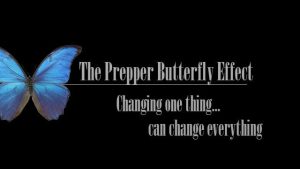Ever wondered what’s the fuss about the new Netflix production – Bandersnatch or commonly known as The Black Mirror, about how minute actions you take without much thinking can have a huge impact on your life and the lives of others or how the things you neglected in the past has changed your present. If yes, then here I am to give you the basics of one of the most fascinating theories of the world – The Butterfly Effect.

What is the Butterfly Effect?
The Butterfly Effect is an idea that says that a small change can make much bigger changes happen. The idea started with weather prediction. Now the term is used for many things; some are scientific, and some are not.
History
The concept of The Butterfly Effect started from the already existing Chaos Theory. In 1961, Edward Lorenz was running a numerical computer model to redo a weather prediction from the middle of the previous run as a shortcut. He entered the initial condition 0.506 from the printout instead of entering the full precision 0.506127 value. The result was a completely different weather scenario. Following this observation, Lorenz wrote:
“At one point I decided to repeat some of the computations in order to examine what was happening in greater detail. I stopped the computer, typed in a line of numbers that it had printed out a while earlier, and set it running again. I went down the hall for a cup of coffee and returned after about an hour, during which time the computer had simulated about two months of weather. The numbers being printed were nothing like the old ones. I immediately suspected a weak vacuum tube or some other computer trouble, which was not uncommon, but before calling for service I decided to see just where the mistake had occurred, knowing that this could speed up the servicing process. Instead of a sudden break, I found that the new values at first repeated the old ones, but soon afterward differed by one and then several units in the last decimal place, and then began to differ in the next to the last place and then in the place before that. In fact, the differences more or less steadily doubled in size every four days or so, until all resemblance with the original output disappeared somewhere in the second month. This was enough to tell me what had happened: the numbers that I had typed in were not the exact original numbers but were the rounded-off values that had appeared in the original printout. The initial round-off errors were the culprits; they were steadily amplifying until they dominated the solution.” (E. N. Lorenz, The Essence of Chaos, U. Washington Press, Seattle (1993), page 134)
Since he could not think of any good name for the discussion, he came up with a poetic name, the Butterfly effect.

Now coming to other real-life examples
What if I told you a normal routine of eating a sandwich led to the World War One? You’d probably stop reading this article right away, but the truth is, yes, it did happen that way. The story goes out like- “Plans to assassinate Archduke Franz Ferdinand by the Black Hand terrorist group had so far been unsuccessful. A grenade lobbed at the Archduke’s motorcade during a visit had missed and hit another car. The Archduke was determined to visit the injured so traveled to the hospital but during the journey, he noticed that the driver was not going down the altered route that had been previously decided.
As the driver began to back out, one of the men assigned to assassinate him – Gavrilo Princip, happened to be buying a sandwich at the corner where the car carrying the Archduke conveniently stopped right outside. Princip shot the Archduke and his wife, which plunged the world into a four-year war with millions of casualties.”
Another example showing the butterfly effect and perhaps the most widely known of all the examples.
In 1905, a young man applied to the Academy of Fine Arts in Vienna, unfortunately for him and us, he was rejected, not once but twice.
That aspiring art student was Adolf Hitler, who after his rejection, was forced to live in the slums of the city and his anti-Semitism grew. He joined the German Army instead of fulfilling his dreams as an artist and the rest is history.
There are many other examples which can be associated with the butterfly effect.
Though things happen as they are meant to be, if we look at the above examples, it would be safe to say that if events as small as eating a sandwich on a particular time at a particular place would not have happened, then the world would have not seen the devastating war.
Now, we look into the scientific reasoning behind the Butterfly Effect because we are students of Engineering and every theory, at least for us, should have a proper, structured explanation that should back that theory for almost all cases.
The Math Involved
Mathematical reasoning behind the Butterfly Effect is the phenomenon commonly referred to as Recurrence, the approximate return of a system towards its initial conditions, together with sensitive dependence on initial conditions, are the two main ingredients for chaotic motion.
If M is the state space for the map f^t, then f^t displays sensitive dependence to initial conditions if, for any x in M and any δ > 0, there are y in M, with distance d(. , .) such that 
for some positive parameter α. The definition does not require that all points from a neighborhood separate from the base point x, but it requires one positive Lyapunov exponent.
The simplest mathematical framework exhibiting sensitive dependence on initial conditions is provided by a particular parametrization of the logistic map:

which, unlike most chaotic maps, has a closed-form solution:

where the initial condition parameter ϴ is given by:
![]()
For rational ϴ, after a finite number of iterations xn maps into a periodic sequence. But almost all ϴ is irrational, and, for irrational ϴ, xn never repeats itself – it is non-periodic. This solution equation clearly demonstrates the two key features of chaos – stretching and folding: the factor 2n shows the exponential growth of stretching, which results in sensitive dependence on initial conditions (the butterfly effect), while the squared sine function keeps xn folded within the range [0, 1]

Clearly, Math plays a huge role in the world we live in. The next time someone asks you about the use of trigonometry and calculus in real life, just tell them about the role it plays in our day to day life and how we can predict or alter our future using this theory, and of course Math.




Comments
Thanks very nice blog!
Hi! I’m at work surfing around your blog from my new iphone!
Just wanted to say I love reading your blog and look forward to
all your posts! Keep up the great work!